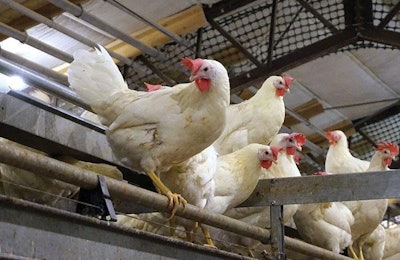
The big story in the U.S. egg industry in 2016 was the number of cage-free purchase pledges made by major retail and foodservice shell egg purchasers, and similar pledges by foodservice and food companies regarding egg products purchases. Most of these cage-free shell egg and egg product purchase pledges are due to take effect in 2025.
In a report released on January 9, 2017, the U.S. Department of Agriculture (USDA) estimated that the number of cage-free egg layers housed in the U.S. had increased to 37.6 million by December 2016, with 14.1 million of these hens being certified organic. The USDA estimated the total table egg layer flock to be 311.6 million hens on December 1, 2016. Based on these USDA estimates, cage-free layers represented 12.1 percent of the total egg-laying flock in December 2016. Egg Industry estimates that no more than 1 percent of the total U.S. table egg layer flock is housed in fully enriched cages.
As part of the Top Egg Company Survey, U.S. egg producers were asked to predict the percentages of the U.S. table egg flock that will be housed in conventional cages, enriched cages and cage free in 2025. Thirty-one egg producers housing 174 million hens answered the opinion questions in the Top Egg Company survey.
The average of the egg producers’ responses was that 47.7 percent of U.S. hens would be housed in conventional cages in 2025. The responses ranged from a high of 80 percent to a low of 0 percent with a median response of 55 percent.
Most U.S. egg producers predict enriched cages will still be used in 2025, with the average prediction that 6 percent of U.S. hens will be housed in enriched cages that year. The responses ranged from 0 percent to 25 percent with 1 percent being the median response.
U.S. egg producers, on average, don’t predict that cage free will be the predominant means of egg production in 2025, with the average of the predictions being 46.3 percent. The responses to this question ranged from 10 to 90 percent with the median response being 40 percent.
Will retail egg sales be 100 percent cage free?
Most major U.S. shell egg retailers have pledged to switch all of their egg purchases to cage free by some future date, generally around 2025. Some of these pledges contain language relating to “affordability and availability” of cage-free eggs.
The U.S. egg market was in an oversupply situation in 2016 for cage-produced and cage-free eggs. Many U.S. consumers have continued to purchase less expensive cage-produced eggs in stores where they are given a choice between cage-produced and cage-free eggs.
U.S. egg producers are not convinced that consumers will change their attitudes regarding cage-free eggs by 2025. They were asked to select the statement regarding cage-free retail egg sales in 2025 that most closely matches what they think will happen. None of the egg producers agreed with the statement, “Cage-free eggs will represent more than 90 percent of eggs sold by retailers that have made pledges.” More than 80 percent of egg producers selected the statements, “Cage-free eggs will represent 50 to 90 percent of eggs sold by retailers that have made pledges” and “Cage-free eggs will represent 30 to 49 percent of eggs sold by retailers that have made pledges.” Nineteen percent of egg producers selected the statement, “Cage-free eggs will represent less than 30 percent of eggs sold by retailers that have made pledges.”
Learn more about last year’s Top Egg Company survey results:
www.WATTAgNet.com/articles/25650
Comprehensive resource for cage-free eggs available
A new collection of exclusive articles, blogs and infographics on Cage-free Eggs and Consumer Trust in the Poultry Industry, written by trusted WATT Global Media editors and industry experts will equip egg producers and marketers with information to help them make critical business decisions. Purchase your copy.


















